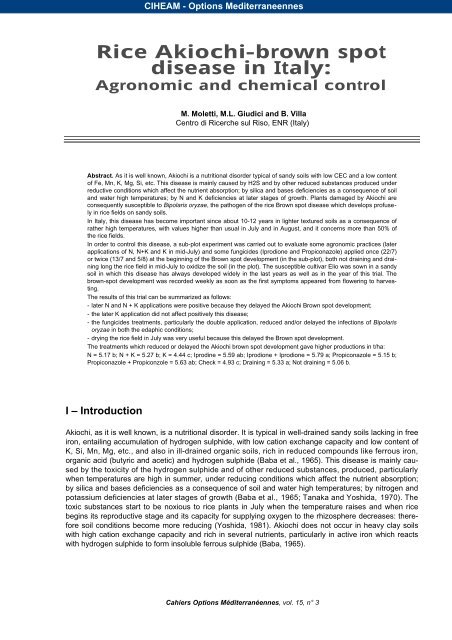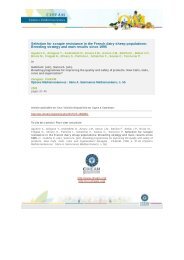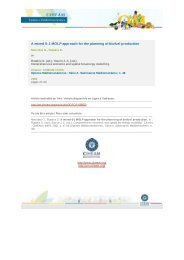Rice Akiochi-brown spot disease in Italy: agronomic and ... - ciheam
Rice Akiochi-brown spot disease in Italy: agronomic and ... - ciheam
Rice Akiochi-brown spot disease in Italy: agronomic and ... - ciheam
You also want an ePaper? Increase the reach of your titles
YUMPU automatically turns print PDFs into web optimized ePapers that Google loves.
Abstract. As it is well known, <strong>Akiochi</strong> is a nutritional disorder typical of s<strong>and</strong>y soils with low CEC <strong>and</strong> a low content<br />
of Fe, Mn, K, Mg, Si, etc. This <strong>disease</strong> is ma<strong>in</strong>ly caused by H2S <strong>and</strong> by other reduced substances produced under<br />
reductive conditions which affect the nutrient absorption; by silica <strong>and</strong> bases deficiencies as a consequence of soil<br />
<strong>and</strong> water high temperatures; by N <strong>and</strong> K deficiencies at later stages of growth. Plants damaged by <strong>Akiochi</strong> are<br />
consequently susceptible to Bipolaris oryzae, the pathogen of the rice Brown <strong>spot</strong> <strong>disease</strong> which develops profusely<br />
<strong>in</strong> rice fields on s<strong>and</strong>y soils.<br />
In <strong>Italy</strong>, this <strong>disease</strong> has become important s<strong>in</strong>ce about 10-12 years <strong>in</strong> lighter textured soils as a consequence of<br />
rather high temperatures, with values higher than usual <strong>in</strong> July <strong>and</strong> <strong>in</strong> August, <strong>and</strong> it concerns more than 50% of<br />
the rice fields.<br />
In order to control this <strong>disease</strong>, a sub-plot experiment was carried out to evaluate some <strong>agronomic</strong> practices (later<br />
applications of N, N+K <strong>and</strong> K <strong>in</strong> mid-July) <strong>and</strong> some fungicides (Iprodione <strong>and</strong> Propiconazole) applied once (22/7)<br />
or twice (13/7 <strong>and</strong> 5/8) at the beg<strong>in</strong>n<strong>in</strong>g of the Brown <strong>spot</strong> development (<strong>in</strong> the sub-plot), both not dra<strong>in</strong><strong>in</strong>g <strong>and</strong> dra<strong>in</strong><strong>in</strong>g<br />
long the rice field <strong>in</strong> mid-July to oxidize the soil (<strong>in</strong> the plot). The susceptible cultivar Elio was sown <strong>in</strong> a s<strong>and</strong>y<br />
soil <strong>in</strong> which this <strong>disease</strong> has always developed widely <strong>in</strong> the last years as well as <strong>in</strong> the year of this trial. The<br />
<strong>brown</strong>-<strong>spot</strong> development was recorded weekly as soon as the first symptoms appeared from flower<strong>in</strong>g to harvest<strong>in</strong>g.<br />
The results of this trial can be summarized as follows:<br />
- later N <strong>and</strong> N + K applications were positive because they delayed the <strong>Akiochi</strong> Brown <strong>spot</strong> development;<br />
- the later K application did not affect positively this <strong>disease</strong>;<br />
- the fungicides treatments, particularly the double application, reduced <strong>and</strong>/or delayed the <strong>in</strong>fections of Bipolaris<br />
oryzae <strong>in</strong> both the edaphic conditions;<br />
- dry<strong>in</strong>g the rice field <strong>in</strong> July was very useful because this delayed the Brown <strong>spot</strong> development.<br />
The treatments which reduced or delayed the <strong>Akiochi</strong> <strong>brown</strong> <strong>spot</strong> development gave higher productions <strong>in</strong> t/ha:<br />
N = 5.17 b; N + K = 5.27 b; K = 4.44 c; Iprod<strong>in</strong>e = 5.59 ab; Iprodione + Iprodione = 5.79 a; Propiconazole = 5.15 b;<br />
Propiconazole + Propiconzole = 5.63 ab; Check = 4.93 c; Dra<strong>in</strong><strong>in</strong>g = 5.33 a; Not dra<strong>in</strong><strong>in</strong>g = 5.06 b.<br />
I – Introduction<br />
CIHEAM - Options Mediterraneennes<br />
<strong>Rice</strong> <strong>Akiochi</strong>-<strong>brown</strong> <strong>spot</strong><br />
<strong>disease</strong> <strong>in</strong> <strong>Italy</strong>:<br />
Agronomic <strong>and</strong> chemical control<br />
M. Moletti, M.L. Giudici <strong>and</strong> B. Villa<br />
Centro di <strong>Rice</strong>rche sul Riso, ENR (<strong>Italy</strong>)<br />
<strong>Akiochi</strong>, as it is well known, is a nutritional disorder. It is typical <strong>in</strong> well-dra<strong>in</strong>ed s<strong>and</strong>y soils lack<strong>in</strong>g <strong>in</strong> free<br />
iron, entail<strong>in</strong>g accumulation of hydrogen sulphide, with low cation exchange capacity <strong>and</strong> low content of<br />
K, Si, Mn, Mg, etc., <strong>and</strong> also <strong>in</strong> ill-dra<strong>in</strong>ed organic soils, rich <strong>in</strong> reduced compounds like ferrous iron,<br />
organic acid (butyric <strong>and</strong> acetic) <strong>and</strong> hydrogen sulphide (Baba et al., 1965). This <strong>disease</strong> is ma<strong>in</strong>ly caused<br />
by the toxicity of the hydrogen sulphide <strong>and</strong> of other reduced substances, produced, particularly<br />
when temperatures are high <strong>in</strong> summer, under reduc<strong>in</strong>g conditions which affect the nutrient absorption;<br />
by silica <strong>and</strong> bases deficiencies as a consequence of soil <strong>and</strong> water high temperatures; by nitrogen <strong>and</strong><br />
potassium deficiencies at later stages of growth (Baba et al., 1965; Tanaka <strong>and</strong> Yoshida, 1970). The<br />
toxic substances start to be noxious to rice plants <strong>in</strong> July when the temperature raises <strong>and</strong> when rice<br />
beg<strong>in</strong>s its reproductive stage <strong>and</strong> its capacity for supply<strong>in</strong>g oxygen to the rhizosphere decreases: therefore<br />
soil conditions become more reduc<strong>in</strong>g (Yoshida, 1981). <strong>Akiochi</strong> does not occur <strong>in</strong> heavy clay soils<br />
with high cation exchange capacity <strong>and</strong> rich <strong>in</strong> several nutrients, particularly <strong>in</strong> active iron which reacts<br />
with hydrogen sulphide to form <strong>in</strong>soluble ferrous sulphide (Baba, 1965).<br />
Cahiers Options Méditerranéennes, vol. 15, n° 3
Plants affected by <strong>Akiochi</strong> become susceptible to Bipolaris oryzae (Breda de Haan) Shoem., the pathogen<br />
of the rice Brown <strong>spot</strong> <strong>disease</strong> which was used as an <strong>in</strong>dex of <strong>Akiochi</strong> (Baba, 1965; Ou, 1985).<br />
Brown <strong>spot</strong> develops profusely <strong>in</strong> rice fields on s<strong>and</strong>y soils, where it causes great damage decreas<strong>in</strong>g<br />
both the gra<strong>in</strong> yield <strong>and</strong> the gra<strong>in</strong> quality (Ou, 1985).<br />
In <strong>Italy</strong>, this <strong>disease</strong> has become important s<strong>in</strong>ce 1982-1983 (Moletti, 1984) <strong>in</strong> lighter textured soils as a<br />
consequence of rather high temperatures, with values higher than usual <strong>in</strong> July <strong>and</strong> <strong>in</strong> August (Table 1),<br />
<strong>and</strong> also as a consequence of the spread<strong>in</strong>g of very susceptible rice varieties like Lido, of the greater soil<br />
compaction (which decreases the water movement <strong>in</strong> <strong>and</strong> on soil), of the cont<strong>in</strong>uous rice cropp<strong>in</strong>g <strong>and</strong> of<br />
the replacement of organic manure with m<strong>in</strong>eral fertilizers. This <strong>disease</strong>, with different crop damage,<br />
concerns about 50% of the Italian rice fields.<br />
T a b l e 1 . Average temperatures <strong>in</strong> May-September recorded at CRR Station at Castello d’Agogna (Pavia),<br />
Grow<strong>in</strong>g Degree Days (GDD) <strong>and</strong> <strong>Akiochi</strong>-Brown <strong>spot</strong> <strong>in</strong>cidence <strong>in</strong> the period 1982-1993, <strong>in</strong> lighter textured<br />
soils <strong>in</strong> <strong>Italy</strong><br />
Average Temperature °C <strong>Akiochi</strong> Brown<br />
Years May June July August September GDD (*) <strong>spot</strong> <strong>in</strong>cidence<br />
1974-1981 15.2 19.1 20.7 20.1 16.5 967.0<br />
1982 18.8 23.2 24.9 23.1 21.3 1566.4 Severe<br />
1983 15.8 21.0 25.5 21.9 18.8 1319.0 Severe<br />
1984 14.2 21.0 24.0 22.2 17.6 1195.6 Low<br />
1985 16.8 19.6 24.1 21.9 19.5 1285.3 Mild<br />
1986 18.6 20.0 21.1 22.0 17.9 1215.3 Mild<br />
1987 15.4 19.5 23.5 22.0 20.8 1257.9 Mild<br />
1988 17.4 19.4 23.0 22.3 18.7 1250.4 Mild<br />
1989 18.8 20.4 23.3 23.0 18.3 1342.5 Mild<br />
1990 19.4 21.1 23.5 23.1 18.8 1408.5 Mild<br />
1991 15.7 20.9 25.1 23.8 19.7 1380.0 Mild<br />
1992 19.8 20.1 23.5 24.4 18.6 1425.3 Severe<br />
1993 19.0 22.2 22.1 24.1 18.5 1404.4 Severe<br />
1974-1993 16.5 20.0 22.5 21.7 18.0 1189.3<br />
(*) GDD = ∑ (daily mean temp. 0°C-12°C), from May to September.<br />
Different k<strong>in</strong>ds of control measures aga<strong>in</strong>st the <strong>Akiochi</strong>-Brown <strong>spot</strong> have been suggested: the varietal<br />
one, employ<strong>in</strong>g resistant genotypes; the <strong>agronomic</strong>al one, adopt<strong>in</strong>g cultivation practices to decrease the<br />
toxic substances <strong>in</strong> soil; the chemical one, us<strong>in</strong>g fungicides aga<strong>in</strong>st Bipolaris oryzae<br />
(Moletti, 1984; 1989). As regards the resistant rice genotypes, among the Italian <strong>and</strong> foreign varieties<br />
tested as well as among some pure l<strong>in</strong>es, most were severely damaged <strong>and</strong> only few genotypes were<br />
not very affected (Moletti, 1989; Moletti et al. 1983; Moletti et al. 1988-1992).<br />
In order to control this <strong>disease</strong>, a trial was carried out to evaluate some <strong>agronomic</strong> practices (later applications<br />
of N, N + K <strong>and</strong> K) <strong>and</strong> some fungicides (Iprodione <strong>and</strong> Propiconazole) applied 1 <strong>and</strong> 2 times at<br />
the beg<strong>in</strong>n<strong>in</strong>g of the Brown <strong>spot</strong> development, both not dra<strong>in</strong><strong>in</strong>g <strong>and</strong> dra<strong>in</strong><strong>in</strong>g long the rice field <strong>in</strong><br />
mid-July to oxidize the soil.<br />
II – Materials <strong>and</strong> methods<br />
The trial was performed <strong>in</strong> 1993 at Tromello (Pavia), <strong>in</strong> a s<strong>and</strong>y soil <strong>in</strong> which <strong>Akiochi</strong>-Brown <strong>spot</strong> has<br />
always developed profusely <strong>in</strong> previous years. The physical <strong>and</strong> chemical characteristic of this soil were<br />
the follow<strong>in</strong>g: s<strong>and</strong> = 81.3%; loam = 15.2%; clay = 3.5%; pH = 5.3; organic m a t t e r = 2 . 6 5 % ;<br />
total N = 0.112%; cation exchange capacity = 3.1 me/100 g soil.<br />
In this experiment, the eight treatments shown <strong>in</strong> Table 2 were compared <strong>in</strong> plots separated by levees,<br />
both not dra<strong>in</strong><strong>in</strong>g <strong>and</strong> dra<strong>in</strong><strong>in</strong>g <strong>in</strong> the whole second decade of July. A strip-plot experiment with four replications<br />
was chosen, with the treatment <strong>in</strong> the plot <strong>and</strong> the not dra<strong>in</strong><strong>in</strong>g or dra<strong>in</strong><strong>in</strong>g <strong>in</strong> the sub-plot, which<br />
measured 50 m2.<br />
80<br />
CIHEAM - Options Mediterraneennes<br />
Cahiers Options Méditerranéennes
Table 2. Agronomic <strong>and</strong> chemical treatments to control the <strong>Akiochi</strong>-Brown <strong>spot</strong> <strong>disease</strong><br />
Treatments Doses per hectare Application time<br />
N 30 kg July 14<br />
K 2 O 54 kg July 12<br />
N + K 2 O 30 kg + 54 kg July 14<br />
Not dra<strong>in</strong>ed rice field Rovral FL 1.6 l July 22<br />
<strong>in</strong> mid-July Rovral FL + Rovral FL 1.6 l + 1.6 l July 13 <strong>and</strong> August 5<br />
Tilt 25 EC 0.5 l July 22<br />
Tilt 25 EC + Tilt 25 EC 0.5 l + 0.5 l July 13 <strong>and</strong> August 5<br />
Check - -<br />
N 30 kg July 14<br />
K 2 O 54 kg July 12<br />
N + K 2 O 30 kg + 54 kg July 14<br />
Dra<strong>in</strong>ed rice field Rovral FL 1.6 l July 22<br />
from 10 to 20 July Rovral FL + Rovral FL 1.6 l + 1.6 l July 13 <strong>and</strong> August 5<br />
Tilt 25 EC 0.5 l July 22<br />
Tilt 25 EC + Tilt 25 EC 0.5 l + 0.5 l July 13 <strong>and</strong> August 5<br />
Check - -<br />
Head<strong>in</strong>g August 4-6<br />
Rovral FL conta<strong>in</strong><strong>in</strong>g 25% of Iprodione; Tilt 25 EC conta<strong>in</strong><strong>in</strong>g 25.25% of Propiconazole. Fungicides were mixed with 400 l/ha of water <strong>and</strong> applied<br />
with an experimental sprayer similar to the farm sprayers.<br />
The susceptible short gra<strong>in</strong> cultivar Elio was sown at the end of April distribut<strong>in</strong>g 180 kg/ha of seed. The<br />
m<strong>in</strong>eral fertilization was carried out some days pre-sow<strong>in</strong>g with basal application of 80-80-150 kg/ha of<br />
N, P 2O 5, <strong>and</strong> K 2O respectively <strong>and</strong> aga<strong>in</strong> 40 kg/ha of N as topdress<strong>in</strong>g <strong>in</strong> June, dur<strong>in</strong>g the tiller<strong>in</strong>g stage.<br />
The other cultural practices were as the traditional ones.<br />
The symptom severity of Brown <strong>spot</strong> was recorded weekly from the beg<strong>in</strong>n<strong>in</strong>g of August, some days after<br />
the symptom appearance, until harvest at the end of September. Symptoms were scored accord<strong>in</strong>g to the<br />
IRRI (International <strong>Rice</strong> Research Institute) scale from 0 to 9 evaluat<strong>in</strong>g the affected leaf area as follows:<br />
0 = no <strong>in</strong>cidence; 1 = less than 1%; 2 = 1-3%; 3 = 4-5%; 4 = 6-10%; 5 = 11-15%; 6 = 1 6-25%; 7 = 2 6 -<br />
50%; 8 = 51-75%; 9 = 76-100%. Moreover, the follow<strong>in</strong>g cultural parameters were evaluated: plant height<br />
on 20 records per plot; panicle density, dry matter <strong>and</strong> gra<strong>in</strong> yield straw ratio on four samples of 0,25 m2<br />
per plot; gra<strong>in</strong> yield by harvest<strong>in</strong>g the whole plot; 1000 seed weight <strong>and</strong> head rice (with Satake test<strong>in</strong>g-m i l l<br />
on 200 g of rough rice) on a sample per plot; kernel discoloration on the sample of head rice.<br />
<strong>Rice</strong> was harvested with a plot comb<strong>in</strong>e at the end of September.<br />
III – Results <strong>and</strong> discussion<br />
CIHEAM - Options Mediterraneennes<br />
In 1993 the weather was favourable to <strong>Akiochi</strong>-Brown <strong>spot</strong>. In fact, <strong>in</strong> the second <strong>and</strong> third decades of<br />
June, temperatures were higher than usual <strong>and</strong> favoured the <strong>disease</strong> development. At the beg<strong>in</strong>n<strong>in</strong>g of<br />
July, <strong>in</strong> advance than usual, the <strong>disease</strong> symptoms were already observed on the lower leaves, particularly<br />
<strong>in</strong> cultivation lack<strong>in</strong>g <strong>in</strong> nitrogen. However, the fall <strong>in</strong> temperature <strong>in</strong> the second <strong>and</strong> third decades<br />
of July slowed down the epidemic which <strong>in</strong>creased aga<strong>in</strong> at the beg<strong>in</strong>n<strong>in</strong>g of August, when the temperature<br />
rose aga<strong>in</strong>, <strong>and</strong> damage was severe, as shown <strong>in</strong> Table 1.<br />
The <strong>disease</strong> progress curves of the different treatments <strong>and</strong> of the two soil conditions (not dra<strong>in</strong>ed <strong>and</strong><br />
dra<strong>in</strong>ed) are shown <strong>in</strong> Figures 1 <strong>and</strong> 2: some treatments gave good results decreas<strong>in</strong>g or delay<strong>in</strong>g the<br />
<strong>disease</strong> development, whereas some others did not affect the <strong>disease</strong> behaviour. The double application<br />
with Iprodione (Rovral) was the best <strong>in</strong> the control of Bipolaris oryzae <strong>and</strong> the double application of<br />
Propiconazole (Tilt) comes just after. On the other h<strong>and</strong> also the s<strong>in</strong>gle applications of this two fungicides<br />
were useful. Interest<strong>in</strong>g results were given also by the later application of N + K or N which delayed the<br />
<strong>disease</strong> development, while the later application of K did not <strong>in</strong>fluence the epidemic. With regard to dra<strong>in</strong><strong>in</strong>g<br />
<strong>in</strong> mid-July, its effect was positive because it decreased the <strong>Akiochi</strong>-Brown <strong>spot</strong> severity.<br />
Cahiers Options Méditerranéennes<br />
81
Figure 1. Disease progress curves of different treatments<br />
Figure 2. Disease progress curves <strong>in</strong> not dra<strong>in</strong>ed <strong>and</strong> dra<strong>in</strong>ed rice fields <strong>in</strong> mid-july<br />
Scale (Brown <strong>spot</strong> affected leaf area): 0 = no <strong>in</strong>cidence; 1 = less than 1%; 2 = 1-3%; 3 = 4-5%; 4 = 6-10%; 5 = 11-15%; 6 = 16-25%; 7 = 26-50%;<br />
8 = 51-75%; 9 = 76-100%.<br />
Values of the recorded ma<strong>in</strong> cultural traits are shown <strong>in</strong> Table 3 as well as the <strong>disease</strong> severity at the dough<br />
stage when most of the reserves are already stored <strong>in</strong> the gra<strong>in</strong> (the record at this stage is the one which<br />
better evidences the relation between the symptom severity <strong>and</strong> the yield values of the various treatments).<br />
The analysis of the data <strong>in</strong>dicates that treatments with fungicides <strong>and</strong> with N + K or N, which decreased or<br />
delayed the <strong>disease</strong> development, gave higher gra<strong>in</strong> yield <strong>in</strong> both soil conditions, with <strong>in</strong>creases between<br />
11 <strong>and</strong> 33%. The highest gra<strong>in</strong> yields were given by the theses with the double fungicide treatment (<strong>in</strong>crease<br />
20-33%), but the <strong>in</strong>creases obta<strong>in</strong>ed were lower than our expectations based on the good plant appearance<br />
related to less Bipolaris oryzae <strong>in</strong>fections. The applications of N + K or N, as well as dra<strong>in</strong><strong>in</strong>g, favoured<br />
the plant growth measured by plant height, panicle density <strong>and</strong> dry matter production.<br />
An <strong>in</strong>terest<strong>in</strong>g trait to which attention should be paid is kernel discoloration: the amount of blotches due<br />
to <strong>in</strong>fect<strong>in</strong>g fungi on milled rice was higher <strong>in</strong> the theses (fungicide treatments, with values between 2.5<br />
<strong>and</strong> 3.2%) where the <strong>in</strong>fection of Bipolaris oryzae on leaves <strong>and</strong> on glumes was fewer; on the contrary it<br />
was lower <strong>in</strong> the theses (Check <strong>and</strong> K, with values from 1.6 to 2.1%) <strong>in</strong> which the lesions of Brown <strong>spot</strong><br />
on leaves <strong>and</strong> on glumes were more numerous. In the theses N <strong>and</strong> N + K with the same trend of the<br />
<strong>disease</strong> development on leaves <strong>and</strong> on glumes for most of the cycle, the amount of blotches on milled<br />
rice was higher <strong>in</strong> N (2-2.5%) <strong>and</strong> lower <strong>in</strong> N + K (1.5-2.1%). It is important to po<strong>in</strong>t out that <strong>in</strong> <strong>Italy</strong> milled<br />
rice can be traded only if damage (discoloration <strong>and</strong> <strong>spot</strong>s) on milled rice is less than 1.5% (this value<br />
can be raised to 2-2.25%, accord<strong>in</strong>g to the variety, <strong>in</strong> particular years with severe damage). Therefore a<br />
treatment which, besides allow<strong>in</strong>g gra<strong>in</strong> yield <strong>in</strong>crease, entails more blotches on milled rice is less useful.<br />
82<br />
Brown <strong>spot</strong> severity<br />
Brown <strong>spot</strong> severity<br />
9<br />
8<br />
7<br />
6<br />
5<br />
4<br />
3<br />
2<br />
1<br />
0<br />
Aug.<br />
4-6<br />
head<strong>in</strong>g<br />
9<br />
8<br />
7<br />
6<br />
5<br />
4<br />
3<br />
2<br />
1<br />
0<br />
Aug.<br />
Check K2O N N + K2O<br />
Aug.<br />
7<br />
Tilt Rovral Tilt + Tilt Rovral + Rovral<br />
Aug.<br />
CIHEAM - Options Mediterraneennes<br />
Aug.<br />
14<br />
Aug.<br />
Aug.<br />
21<br />
Aug.<br />
Aug.<br />
28<br />
Aug.<br />
Sept.<br />
4<br />
Not dra<strong>in</strong>ed Dra<strong>in</strong>ed Dra<strong>in</strong>ed<br />
Sept.<br />
11<br />
Cahiers Options Méditerranéennes<br />
Sept.<br />
19<br />
Sept.<br />
26<br />
Sept.<br />
28<br />
harvest<br />
4-6 7 14 21 28 4 11 19 26 28<br />
head<strong>in</strong>g harvest<br />
Sept.<br />
Sept.<br />
Sept.<br />
Sept.<br />
Sept.
Table 3. Disease severity <strong>and</strong> values of the ma<strong>in</strong> <strong>agronomic</strong> traits got with different cultural <strong>and</strong> chemical<br />
treatments<br />
Treatments Disease Gra<strong>in</strong> yield Head Kernel Plant Panicle Dry 1000 Gra<strong>in</strong><br />
severity (2) % of rice discolo- height density matter seed yield/<br />
ration weight straw<br />
(1) t/ha check % % cm no./m2 g/m2 g<br />
Not dra<strong>in</strong>ed rice field <strong>in</strong> mid-July<br />
Check 7.5 4.38 100.0 63.3 1.6 73.5 364 1003 25.2 0.80<br />
K 2 O 8.3 4.20 95.9 64.9 1.6 71.3 383 995 25.1 0.77<br />
N 7.3 4.87 111.2 62.7 2.0 78.0 415 1181 25.2 0.73<br />
N + K 2 O 6.9 4.99 113.9 63.0 1.5 76.5 398 1124 25.1 0.78<br />
Tilt 5.9 4.99 113.9 62.7 2.5 71.9 361 1093 25.5 0.95<br />
Rovral 5.1 5.58 127.4 63.8 2.5 74.2 419 1246 25.2 0.82<br />
Tilt + Tilt 4.4 5.64 128.8 62.5 2.7 75.3 401 1246 25.5 0.86<br />
Rovral + Rovral 3.9 5.83 133.1 62.2 2.5 75.2 376 1186 25.7 0.88<br />
Dra<strong>in</strong>ed rice field <strong>in</strong> mid-July<br />
Check 7.3 4.68 100.0 64.3 2.1 73.8 379 1055 25.6 0.79<br />
K 2 O 7.0 4.67 99.8 63.6 2.0 74.3 398 1057 25.1 0.79<br />
N 5.9 5.47 116.9 64.2 2.5 77.2 465 1312 25.2 0.82<br />
N + K 2 O 6.0 5.55 118.6 64.3 2.1 79.1 447 1237 25.3 0.74<br />
Tilt 4.9 5.30 113.2 63.2 3.0 73.2 407 1204 25.5 0.86<br />
Rovral 4.3 5.59 119.4 64.2 3.2 74.3 417 1304 25.5 0.83<br />
Tilt + Tilt 3.8 5.61 119.9 64.9 3.2 74.2 386 1205 25.4 0.82<br />
Rovral + Rovral 3.4 5.75 122.9 65.2 3.2 74.7 389 1268 25.8 0.77<br />
Means<br />
CIHEAM - Options Mediterraneennes<br />
Check 7.4 4.53 c 100.0 63.8 a 1.9 c 73.6b 371 c 1029 c 25.4 a 0.80a<br />
K 2 O 7.6 4.44 c 98.0 64.2 a 1.8 c 72.8b 390 bc 1026 c 25.1a 0.78a<br />
N 6.6 5.17 b 114.1 63.5 a 2.2 bc 77.6a 440 a 1247 ab 25.2 a 0.77a<br />
N + K 2 O 6.4 5.27 b 116.3 63.7 a 1.8 c 77.8a 422 ab 1180 ab 25.2a 0.76a<br />
Tilt 5.4 5.15 b 113.7 62.9 a 2.8 ab 72.5b 384 bc 1148 b 25.5a 0.90a<br />
Rovral 4.7 5.59 ab 123.4 64.0 a 2.9 a 74.2b 418 ab 1275 a 25.3 a 0.83a<br />
Tilt + Tilt 4.1 5.63 ab 124.3 63.7 a 3.0 a 74.7b 393 bc 1226 ab 25.4a 0.84a<br />
Rovral + Rovral 3.6 5.79 a 127.8 63.7 a 2.8 ab 74.9b 382 bc 1227 ab 25.7 a 0.83a<br />
Not dra<strong>in</strong>ed rice field 6.1 5.06 b 100.0 63.1 a 2.1 b 74.5b 389 a 1134 a 25.3 a 0.82a<br />
Dra<strong>in</strong>ed rice field 5.9 5.33 a 105.3 64.2 a 2.7 a 75.1a 411 a 1205 a 25.4a 0.80a<br />
(1) On 4 September at dough stage.<br />
(2) Data at 14% moisture content.<br />
Means followed by the same letter are not significantly different at P < 0.05 (Duncan’s test).<br />
In order to better underst<strong>and</strong> these different results, the samples of rough rice of the treatments were<br />
observed. It emerged that blotches on dehulled rice occurred <strong>in</strong> the centre of the kernel surface or near<br />
the apex, under the gaps where lemma <strong>and</strong> palea hook each other. Moreover the more numerous gaps<br />
were, the more numerous blotches were, which were absolutely unrelated to the <strong>disease</strong> development<br />
on leaves <strong>and</strong> on glumes.<br />
Fungi found on blotches were mostly the follow<strong>in</strong>g: Bipolaris oryzae, A l t e r n a r i a spp., C u r v u l a r i a s p p . ,<br />
Epicoccum purpurascens, Nigrospora oryzae.<br />
With regard to the gaps of hulls, it is necessary to po<strong>in</strong>t out that they are not attributable to the storage of<br />
greater amount of reserves <strong>in</strong> spikelets, because the 1000 seed weight was almost the same <strong>in</strong> all the<br />
treatments. More likely the greater number of gaps <strong>in</strong> some theses is attributable to a lower silicization of<br />
hulls (Bechtel <strong>and</strong> Pomeranz, 1978).<br />
Records on rough rice show that gaps of hulls <strong>and</strong> consequently also kernel discoloration were more frequent<br />
<strong>in</strong> the theses <strong>in</strong> which plants had more vegetative vigour (thus with less silicized tissues) <strong>and</strong><br />
rema<strong>in</strong>ed green longer because of the application of N or of fungicides, as well as ow<strong>in</strong>g to the effect of<br />
Cahiers Options Méditerranéennes<br />
83
dra<strong>in</strong><strong>in</strong>g <strong>in</strong> mid-J u l y . However, it is <strong>in</strong>terest<strong>in</strong>g to po<strong>in</strong>t out that <strong>in</strong> the theses <strong>in</strong> which potassium was<br />
applied s<strong>in</strong>gly or mixed with nitrogen the amount of blotches was smaller than <strong>in</strong> the check <strong>and</strong> <strong>in</strong> the<br />
thesis with only N respectively.<br />
On the basis of these data, it could be supposed that the later K application, probably, helped <strong>in</strong> improv<strong>in</strong>g<br />
the hook<strong>in</strong>g between lemma <strong>and</strong> palea which consequently opened less. This hypothesis agrees<br />
with Noguchi <strong>and</strong> Sugawara (1966) who observed that potassium deficiency decreases the silica accumulation<br />
<strong>in</strong> cells. On the contrary, the content of silica <strong>in</strong> the plant <strong>in</strong>creases with the level of supplied<br />
potassium.<br />
With regard to the relation between nitrogen <strong>and</strong> silicon, it is known that if the former <strong>in</strong>creases <strong>in</strong> the<br />
plant, the latter decreases (Yoshida, 1981). As a consequence, the <strong>in</strong>creas<strong>in</strong>g of blotches with the<br />
<strong>in</strong>creas<strong>in</strong>g of the nitrogen application could be expla<strong>in</strong>ed by the less silicization of hulls which consequently<br />
open more.<br />
The nitrogen application is negative for the kernel discoloration, but it is positive because it delays or<br />
decreases the <strong>Akiochi</strong>-Brown <strong>spot</strong> development: <strong>in</strong> fact it has been reported that nitrogen deficiency <strong>in</strong><br />
soil after the middle of the growth period favours the early appearance of hydrogen sulphide; on the<br />
contrary, the nitrogen presence delays the hydrogen sulphide formation, therefore also the <strong>disease</strong> development<br />
(Yoshida, 1981; Ou, 1985).<br />
IV – Conclusions<br />
The results of this experiment seem to be rather useful <strong>in</strong> practice <strong>and</strong> they can be summarised as follows:<br />
❏ The fungicide treatments of plants, both with the s<strong>in</strong>gle <strong>and</strong> the double application, controlled Bipolaris<br />
oryzae well <strong>and</strong> gave an <strong>in</strong>terest<strong>in</strong>g gra<strong>in</strong> yield <strong>in</strong>crease which varied from 13 to 33%; obviously, the<br />
double application gave the best results. Iprodione (Rovral) worked a little better than Propiconazole<br />
(Tilt). As regards the application time, the results atta<strong>in</strong>ed <strong>in</strong> this <strong>and</strong> <strong>in</strong> other trials show that the best<br />
period for treatments is the second half of July, as soon as the symptoms appear on the lower leaves.<br />
An unresolved problem about the fungicide treatments is the <strong>in</strong>crease of kernel discoloration.<br />
❏ The various <strong>agronomic</strong> practices were positive because they delayed the <strong>disease</strong> development. Some<br />
of them (N + K <strong>and</strong> N) gave gra<strong>in</strong> yield <strong>in</strong>creases between 11 <strong>and</strong> 18%, another (K) did not affect the<br />
gra<strong>in</strong> yield positively. Potassium, however, gave some positive effects because it decreased kernel<br />
discoloration. The best result was obta<strong>in</strong>ed by the application of N + K ow<strong>in</strong>g to the gra<strong>in</strong> yield <strong>in</strong>crease<br />
related to nitrogen <strong>and</strong> ow<strong>in</strong>g to the fewer kernel discoloration related to potassium.<br />
The effect of dra<strong>in</strong><strong>in</strong>g <strong>in</strong> mid-July was also positive because it decreased the <strong>Akiochi</strong>-Brown <strong>spot</strong> severity<br />
<strong>and</strong> <strong>in</strong>creased the gra<strong>in</strong> yield.<br />
Anyhow further trials have to be carried out also with other varieties to confirm the already atta<strong>in</strong>ed<br />
results, to verify the hypotheses put forward <strong>and</strong> to clarify the unresolved problems.<br />
In conclusion, if <strong>in</strong> <strong>Italy</strong> weather went on be<strong>in</strong>g warmer than <strong>in</strong> the past, besides us<strong>in</strong>g varieties less susceptible,<br />
<strong>in</strong> order to decrease the <strong>Akiochi</strong>-Brown <strong>spot</strong> damage to rice, it is advisable to adopt the follow<strong>in</strong>g<br />
<strong>agronomic</strong> practices: dra<strong>in</strong><strong>in</strong>g long <strong>in</strong> mid-July, later N + K application, organic manure utilization,<br />
use of fertilizers conta<strong>in</strong><strong>in</strong>g iron, magnesium, manganese, silicon, etc. (furnace slag), less soil compaction,<br />
deep <strong>and</strong> runn<strong>in</strong>g water <strong>in</strong> warm months, delay sow<strong>in</strong>g so that the reproductive stage <strong>and</strong> the ripen<strong>in</strong>g<br />
occur with temperatures not too high. Moreover, obviously, the fungicides Iprodione <strong>and</strong><br />
Propiconazole, which control Bipolaris oryzae, could be applied; their use, however, might be <strong>in</strong>tegrated<br />
with the overmentioned cultivation practices directed to improve the soil conditions, which are the primary<br />
factor <strong>in</strong>duc<strong>in</strong>g the <strong>disease</strong> development.<br />
84<br />
CIHEAM - Options Mediterraneennes<br />
Cahiers Options Méditerranéennes
References<br />
CIHEAM - Options Mediterraneennes<br />
• Baba I. (1965). Physiological <strong>in</strong>jury. In: Theory <strong>and</strong> Practice of Grow<strong>in</strong>g <strong>Rice</strong> (Eds. Matsubayashi M., Ito R., Nomoto T., Takase<br />
T., Yamada N.), Fuji Publish<strong>in</strong>g Co. Ltd., Tokyo, pp. 149-158.<br />
• B a b a I . , Inada K. <strong>and</strong> Tajima K. ( 1 9 6 5 ) . M<strong>in</strong>eral nutrition <strong>and</strong> physiological <strong>disease</strong>s. In: The m<strong>in</strong>eral nutrition of rice plant.<br />
Proceed<strong>in</strong>gs of a Symposium at IRRI, February 1964, John Hopk<strong>in</strong>s Press, Baltimore, Maryl<strong>and</strong>, pp. 173-195.<br />
• Bechtel D.B. <strong>and</strong> Pomeranz Y. (1978). Implications of the rice kernel structure <strong>in</strong> storage, market<strong>in</strong>g, <strong>and</strong> process<strong>in</strong>g: a review.<br />
J. Food Sci., 43: 1538-1542.<br />
• Moletti M. (1984). Le avversità della stagione ‘83. Terra e vita, XXV(9): 40-43.<br />
• — (1989). Alcune malattie del riso <strong>in</strong> Italia. Informatore Fitopatologico, XXXIX(3): 29-36.<br />
• Moletti M., Giudici M.L., Villa B. (var. an.). Valutazione della reazione di alcuni genotipi di riso all’Elm<strong>in</strong>tosporiosi. Centro di<br />
<strong>Rice</strong>rche sul Riso. Ente Nazionale Risi. Relazione sull’attività svolta nel 1988, pp. 46-47; nel 1989, pp. 51-53; nel 1990, pp. 58-61;<br />
nel 1991, pp. 8-10; nel 1992, pp. 8-10.<br />
• Moletti M., Nipoti E., Villa B. (1983). Reazione di alcuni genotipi all’Elm<strong>in</strong>tosporiosi. Centro di <strong>Rice</strong>rche sul Riso. Ente Nazionale<br />
Risi, Mortara. Relazione sull’attività svolta nel 1983, pp. 60-62.<br />
• Noguchi Y. <strong>and</strong> Sugawara T. (1966). Effects of potassium on the growth, yield, histological structure <strong>and</strong> metabolism of rice<br />
plants. International Potash Institute, Berne, Switzerl<strong>and</strong>, p.102.<br />
• Ou S.H. (1985). <strong>Rice</strong> Diseases. Commonwealth Mycological Institute, Kew, Surrey, Engl<strong>and</strong>, p. 380.<br />
• Tanaka A. <strong>and</strong> Yoshida S. (1970). Nutritional disorders of rice plant <strong>in</strong> Asia. Int. <strong>Rice</strong> Res. Inst. Tech. Bull., no.10.<br />
• Yoshida S. (1981). Fundamentals of rice crop science. International <strong>Rice</strong> Research Institute, Los Baños, Philipp<strong>in</strong>es, p. 269.<br />
Cahiers Options Méditerranéennes<br />
85

















